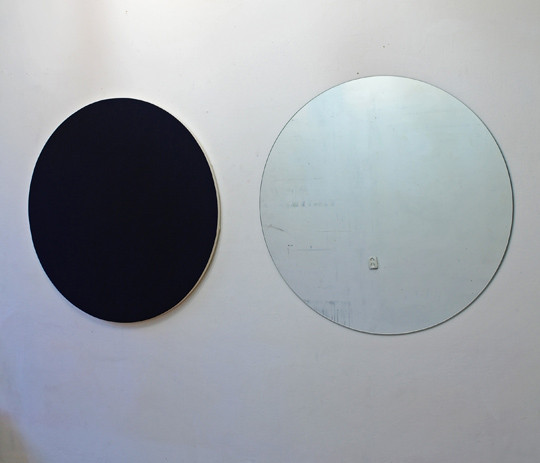Ákos Birkás
08 Nov 2012 - 02 Feb 2013
ÁKOS BIRKÁS
Photo works 1975-1978
8 November 2012 - 2 February 2013
Ákos Birkás became well-known as painter who concentrates on contemporary situations, but between 1975 and 1978 he worked solely with the medium of photo and textes - connected with his photographs. He explains the reasons in an interview, published in the new thematical catalogue:
„I was a painter, I loved painting, and I was attached to it in a way, but I couldn’t be. The problem was that painting was a language that belonged to the discourse of the official powers. Whatever you said in the language of painting somehow became a part of the ongoing dialogue between the political authorities and the intelligentsia, simply because the cultural policy of the day accepted painting as a language. And I felt that everything turned false in the texture of this dialogue. Granted, I managed to maneuver myself into a completely marginal position as a painter by the seventies, but I still couldn’t help feeling that my paintings could always be used – independently of me – and they could sink into the disgusting sewer system of manipulated communication. So I slowly realized that I would have to use a language other than painting, a language not only frowned upon by the representatives of official power, but also one they didn’t understand, because they did not consider it a language to begin with. The “alternative use of photography” was such a non- language at the time. Photography also seemed more suitable, of course, for approaching the kinds of new problems I reached in my prior work in painting. The experience of painting or, more precisely, of art history as a whole had become a sort of encased dead matter for me by then. I carried it with me or rather I attached myself to this huge parcel. This was perhaps my most fundamental and, at the same time, most noble knowledge of the world, which singled me out and differentiated me from others. But in the mid-seventies (or perhaps the late sixties when I finished my studies?) I gradually had to realize that this huge baggage was dead (from my perspective, at least). So I didn’t see it this way from the start, out of some radical impulse, like a faithless person who wanders into a Catholic church and exclaims about how ridiculous this waxworks is. My attitude was changing step by step, in a negotiation with myself, as if I were dismantling myself, driven by a tortuous need to face the truth.“
All shown photographs are vintage prints.
Photo works 1975-1978
8 November 2012 - 2 February 2013
Ákos Birkás became well-known as painter who concentrates on contemporary situations, but between 1975 and 1978 he worked solely with the medium of photo and textes - connected with his photographs. He explains the reasons in an interview, published in the new thematical catalogue:
„I was a painter, I loved painting, and I was attached to it in a way, but I couldn’t be. The problem was that painting was a language that belonged to the discourse of the official powers. Whatever you said in the language of painting somehow became a part of the ongoing dialogue between the political authorities and the intelligentsia, simply because the cultural policy of the day accepted painting as a language. And I felt that everything turned false in the texture of this dialogue. Granted, I managed to maneuver myself into a completely marginal position as a painter by the seventies, but I still couldn’t help feeling that my paintings could always be used – independently of me – and they could sink into the disgusting sewer system of manipulated communication. So I slowly realized that I would have to use a language other than painting, a language not only frowned upon by the representatives of official power, but also one they didn’t understand, because they did not consider it a language to begin with. The “alternative use of photography” was such a non- language at the time. Photography also seemed more suitable, of course, for approaching the kinds of new problems I reached in my prior work in painting. The experience of painting or, more precisely, of art history as a whole had become a sort of encased dead matter for me by then. I carried it with me or rather I attached myself to this huge parcel. This was perhaps my most fundamental and, at the same time, most noble knowledge of the world, which singled me out and differentiated me from others. But in the mid-seventies (or perhaps the late sixties when I finished my studies?) I gradually had to realize that this huge baggage was dead (from my perspective, at least). So I didn’t see it this way from the start, out of some radical impulse, like a faithless person who wanders into a Catholic church and exclaims about how ridiculous this waxworks is. My attitude was changing step by step, in a negotiation with myself, as if I were dismantling myself, driven by a tortuous need to face the truth.“
All shown photographs are vintage prints.

